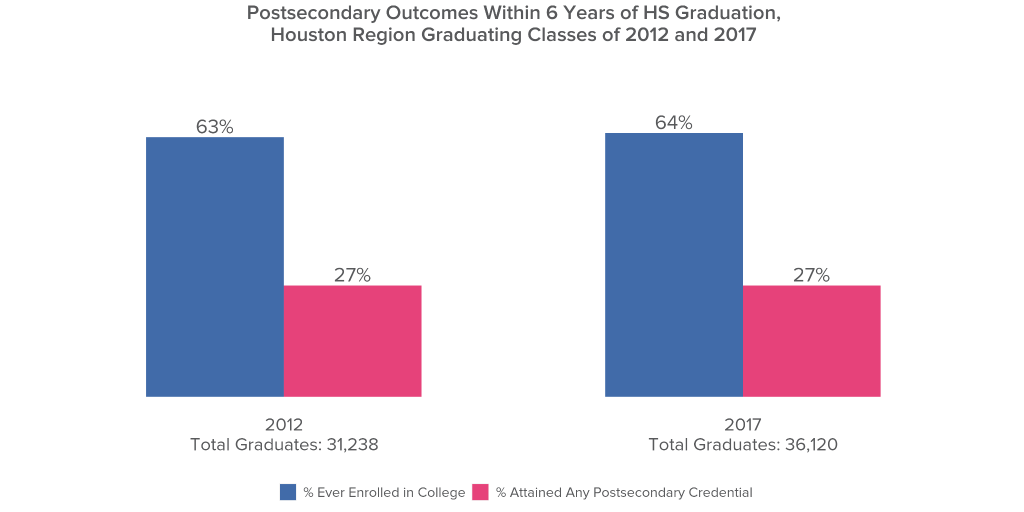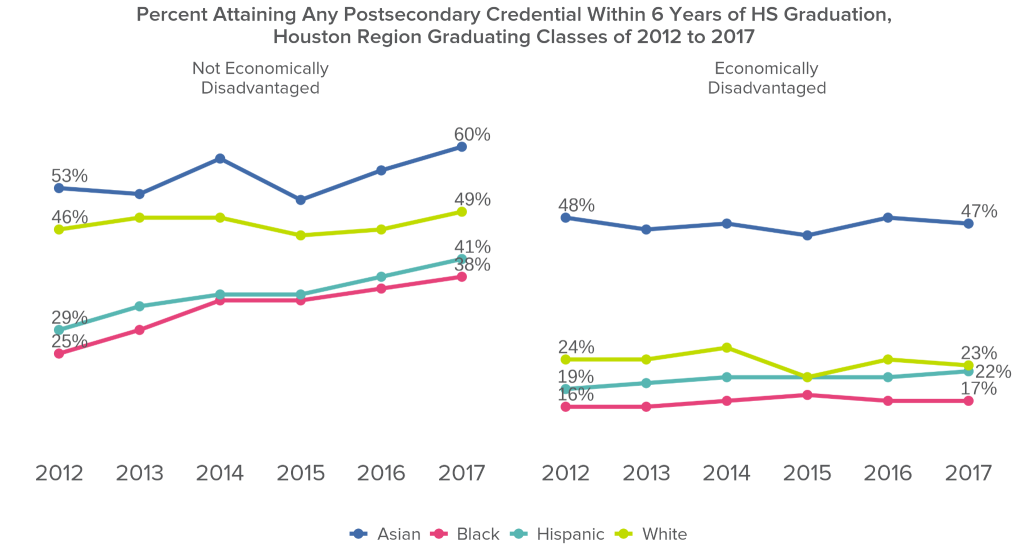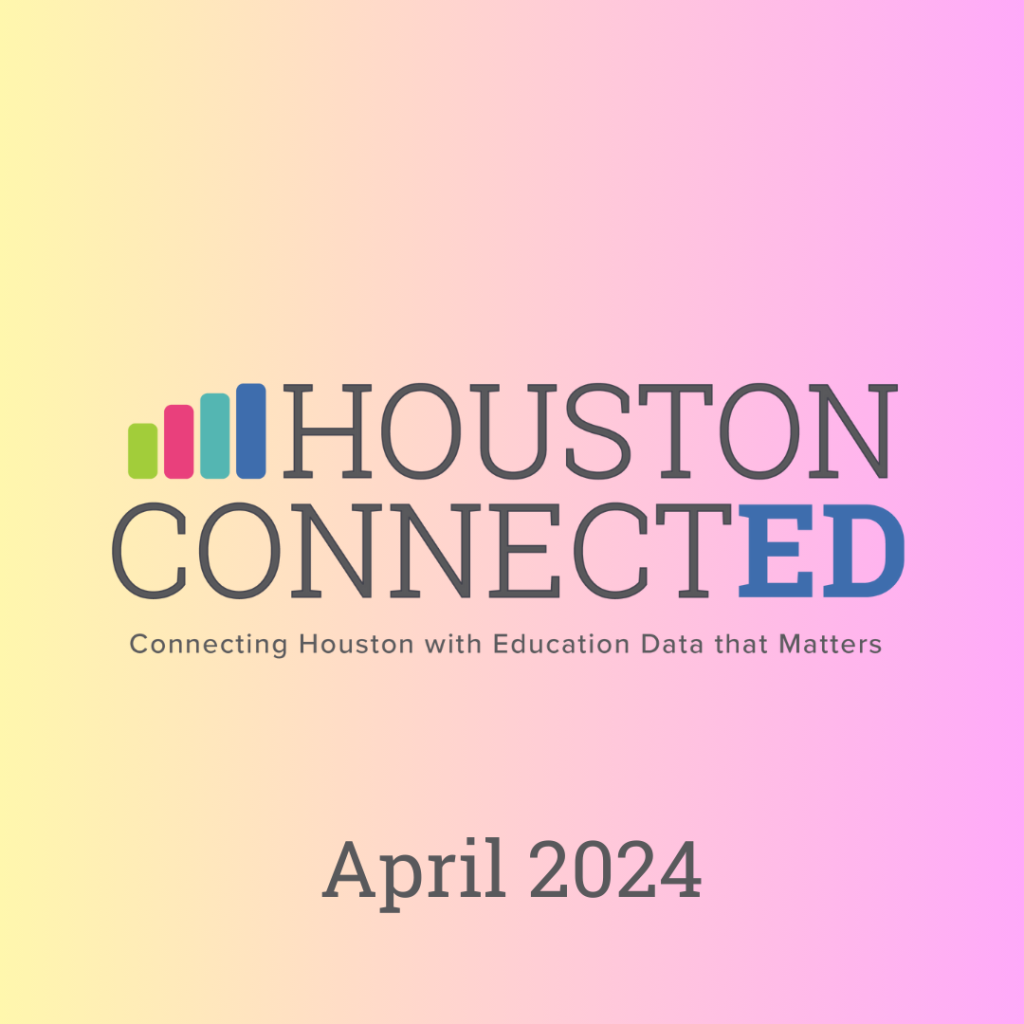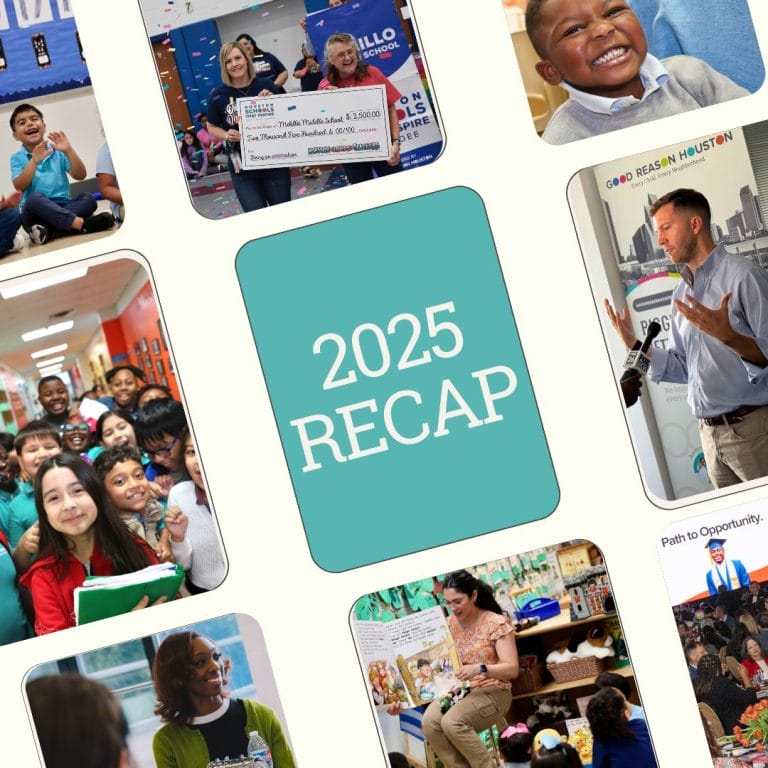Dear Partner,
Welcome to the second edition of Houston ConnectEd, Good Reason Houston’s monthly series spotlighting important education data research and trends.
Each month, we deliver a comprehensive data digest showcasing analyses conducted by our team alongside a roundup of noteworthy education-data news items that have caught our attention. Our aim is to leverage data as an important tool to sharpen our shared perspective on what’s happening in and around Houston’s schools.
In this issue, we dive into preliminary results from our ongoing study of postsecondary outcomes in the Houston region and discuss the urgent need for more publicly available data on long-term student success.
As you have questions or thoughts on the work highlighted here, please reach out to us at info@goodreasonhouston.org, or join us on social media using #HTXConnectEd.
Sincerely,

In this email, we’ll provide you with:
Postsecondary Outcomes | The Need for Publicly Available Outcome Data | Data in the News
Houston Region Postsecondary Outcomes
Late last year, Good Reason Houston was approved by a state board of advisors to gain access to the University of Houston Education Research Center (ERC). This secure data repository lets us look across and connect data sources from various state agencies on everything from K-12 education, to higher education enrollment and completion, to employment and wages. Through original data analysis, Good Reason Houston hopes to sharpen our regional understanding of how students’ K-12 experiences are preparing them for postsecondary success, so that we can both build upon what’s working and address gaps as needed.
The first phase of this long-term project focused on exploring Houston region graduates’ higher education outcomes. As we’ll discuss further below, until just this month the most up-to-date data made available publicly was from the high school class of 2013. Through our ERC study, we’re thrilled to be able to add four additional graduating classes, all of which have had at least six years since graduating high school, and to share with you some important insights for the classes of 2012 to 2017. In addition, we’re also now able to look at postsecondary outcomes for graduates across student groups, including race or ethnicity and socioeconomic status.
- College enrollment and postsecondary credential attainment didn’t change much from 2012 to 2017. Across the Houston region, typically right around 60% of high school graduates enrolled in college within six years of high school graduation for each of the classes of 2012 to 2017. Only 27-28% of graduates from each of those classes attained some type of postsecondary credential within six years. Postsecondary credentials include professional certifications, associate’s degrees, and bachelor’s degrees.

- This trend of flat college enrollment and credential attainment held across degree types and different race or ethnicity groups. In many cases, a broad data trend like stagnant college enrollment over time might be masking significant variation if you dig deeper into the numbers. But, when you look at different credential types or graduates from different racial or ethnic backgrounds, that isn’t the case here. 18% of Houston-region 2012 graduates attained bachelor’s degrees, and 18% of 2017 graduates attained bachelor’s degrees. 2017 graduates were only 1 percentage point more likely to attain an associate’s degree than 2012 graduates. This held across students from different race and ethnic backgrounds, too–none of Black, Hispanic, or white graduates overall were meaningfully more likely to attain a credential in 2017 than in 2012.
- There were, however, very different trajectories for students from different economic circumstances. Students from economically disadvantaged backgrounds saw only a 2-point increase in the likelihood of attaining a postsecondary credential between the classes of 2012 to 2017, from 20% to 22%. Students from more affluent backgrounds, on the other hand, were 11 points more likely to attain credentials, up to 40% in 2017 from 29% in 2012. This trend is covered up when looking only at credential attainment for all graduates because students from economically disadvantaged backgrounds make up the vast majority of Houston-region graduates, so their numbers drive the overall trend described above.

- The growth in credential attainment for non-economically disadvantaged students was driven almost entirely by graduates of color. Digging one level further, when looking at the cross-section of economic circumstances with racial or ethnic background, we found that virtually all of the gains in credential attainment for non-economically disadvantaged graduates came from increases among graduates of color. Non-economically disadvantaged Black graduates from 2017 were 13 points more likely to attain credentials than those from 2012, while Asian and Hispanic graduates were 7 and 12 points more likely, respectively. Non-economically disadvantaged white graduates, conversely, saw gains of only 3 points. Credential attainment was flat among all race/ethnicity groups for students from economically disadvantaged backgrounds.

So, while we haven’t seen much change in outcomes for our graduates overall, we do see that some graduates from some groups–including some from historically marginalized racial or ethnic backgrounds–did see growth between the classes of 2012 to 2017.
This is just the first phase of a long-term study looking into the connections between students’ PK-12 experiences and long-term outcomes, and we’re excited to continue sharing insights in the months to come. We will explore how students’ academic success and program participation influence their postsecondary outcomes, including college enrollment, credential completion, employment, and wages. To illuminate the “why” behind what the numbers tell us, Good Reason Houston will also speak with graduates and families about their lived experiences navigating the transition from PK-12 to the postsecondary world. Our aim is to paint a rich, nuanced picture of how our PK-12 system prepares graduates, and identify strategies to build structures that set them up for sustained, long-term success.
Publicly Available Postsecondary Outcomes Data Limitations
This discussion raises important considerations around the limitations of publicly available higher education outcomes data. We mentioned above that, until April 2024, the most recent publicly available data connecting K-12 graduates with postsecondary outcomes was from the class of 2013, despite an additional four graduating cohorts having had the typical six years since high school graduation to measure postsecondary outcomes. Encouragingly, the Texas Higher Education Coordinating Board (THECB) just released data through the high school class of 2016. However, even those most recently available data do not disaggregate outcomes by student group, meaning that they do not allow for the discovery of trends like those discussed above.
In addition, even more robust publicly available data from the Texas Education Agency (TEA) or THECB do not allow for disaggregation by the cross-section of student groups. For example, through publicly available TEA data we can understand lots about how either Black or economically disadvantaged students perform on STAAR, but we cannot understand anything about how Black, economically disadvantaged students are doing.
Understanding trends in postsecondary outcomes is critical for school district leaders, policymakers, and families to make informed decisions about education in Texas. Understanding how different student groups are doing comparatively is critical to ensuring that students with the greatest need are receiving the lion’s share of resources and support aimed at setting them up for long-term success. We encourage agencies like TEA and THECB to coordinate to connect and disaggregate these data and make them more readily available publicly to reduce the lag between collecting the data, analyzing it, and taking action to better support students and families.
Data in the News
Here are some of the education-data news items we’ve been keeping our eye on over the past few weeks.
Why Schools Absences Have “Exploded” Everywhere: The rise in missed school nationwide may be the key driver behind the slow recovery from pandemic-related learning loss. This story explores a variety of factors likely driving the rise in chronic absenteeism – including changed norms around missing school for fun or when sick and increased student anxiety.
70,000 Fewer FAFSA Submissions from Texas Graduates So Far: Major changes and delays to the Free Application for Federal Student Aid (FAFSA) process have led to dramatic declines in FAFSA completion across the country. In Texas, 70,000 fewer seniors from the class of 2024 have submitted FAFSAs compared to this time last year. Experts are concerned that this will cause a drop in college enrollment for new and returning students, and the potential decline will disproportionately affect students from historically marginalized backgrounds.
Texas Will Use Computers to Grade Written Answers on This Year’s STAAR Test: Last year’s changes to STAAR assessments included increases in the number of open-ended, or “constructed response,” questions. This year, TEA will be utilizing a computer system trained on thousands of potential test responses to help grade the exams. Though responses the computer system has low confidence in will be referred to human graders, the use of an automated system nonetheless raises potential concerns about how the system will treat answers of students from certain groups, such as those who speak a language other than English at home or those receiving special education services.




